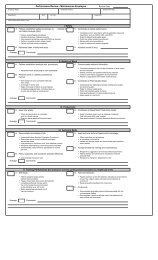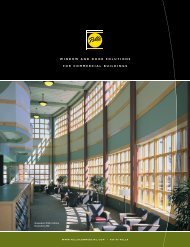Building Operating Management September 2011 - FacilitiesNet
Building Operating Management September 2011 - FacilitiesNet
Building Operating Management September 2011 - FacilitiesNet
Create successful ePaper yourself
Turn your PDF publications into a flip-book with our unique Google optimized e-Paper software.
74<br />
buildingoperatingmanagement<br />
SEPTEMBER <strong>2011</strong><br />
SIKA SARNAFIL<br />
has been as a result of increased volatile<br />
organic compound (VOC) regulations<br />
affecting solvent-based adhesives. The<br />
current VOC level of adhesives is 20 percent<br />
of the total material content. Solvents<br />
are primarily added to adhesives<br />
to improve their adhesion capabilities.<br />
In the older adhesive technologies, low<br />
solvent content produced a thick adhesive<br />
that was hard to apply. As more solvent<br />
was added, the adhesive became<br />
lighter and easier to apply.<br />
Adhesive manufacturers have<br />
been working since the late ‘90s on<br />
producing quality adhesives that meet<br />
the current VOC content regulations.<br />
These regulations have led to the increase<br />
of water-based adhesives. There<br />
A new reflective PVC roof was one of<br />
several recent renovations at Attleboro<br />
High School in Attleboro, Mass.<br />
Top of the world.<br />
Meeting current and emerging needs . . . for on top of a low-slope roof.<br />
Solutions Center<br />
1-800-786-1492<br />
You need it. We’ve got it . . .<br />
Individualized Assistance<br />
Attention to Detail<br />
Project Level Technical Assistance<br />
Alternative Methods of Installation<br />
1-800-786-1492<br />
www.mulehide.com<br />
<br />
<br />
<br />
<br />
<br />
<br />
<br />
®<br />
<br />
<br />
<br />
<br />
® ® <br />
<br />
<br />
<br />
® <br />
<br />
® ® <br />
<br />
<br />
<br />
<br />
<br />
has been a significant improvement<br />
in low VOC solvent-based adhesives<br />
and some U.S. manufacturers can<br />
now produce solvent-based adhesives<br />
with no VOC content. Some single-ply<br />
manufacturers are offering latex/neoprene-bonding<br />
adhesives that also are<br />
produced with no solvents.<br />
Mechanically attached systems are<br />
also becoming more common. One of<br />
the primary concerns regarding mechanically<br />
attached membranes has<br />
been their susceptibility to wind flutter,<br />
which creates substantial interior<br />
noise and contributes to membranefastener<br />
separation. A primary reason<br />
for the membrane’s roof flutter is the<br />
width of the sheets.<br />
When mechanically attached systems<br />
were first introduced, the most<br />
common width of the sheets was five<br />
feet. This allowed for sufficient fastening<br />
attachment and limited the chance<br />
of wind flutter. Over the years, the effort<br />
to reduce labor costs led to wider<br />
sheets — 10 to 12 feet in width. These<br />
expanded widths have contributed to<br />
the susceptibility of wind flutter.<br />
In an effort to eliminate roof flutter<br />
in these sheets, at least one manufacturer<br />
has developed a securement<br />
system that heats the existing fastener<br />
plates to allow for adhesion of<br />
the membrane to the plates without<br />
membrane penetration. The system<br />
provides more attachment points,<br />
which ultimately eliminates roof flutter.<br />
The system includes three primary<br />
components — the induction welder,<br />
a set of magnetic cooling weights and<br />
▲ FREE INFO: Circle 447





